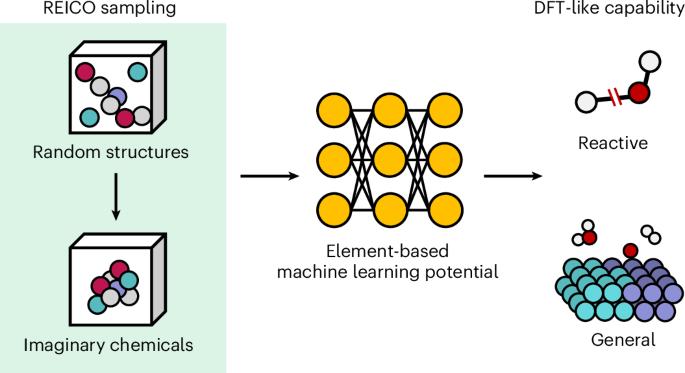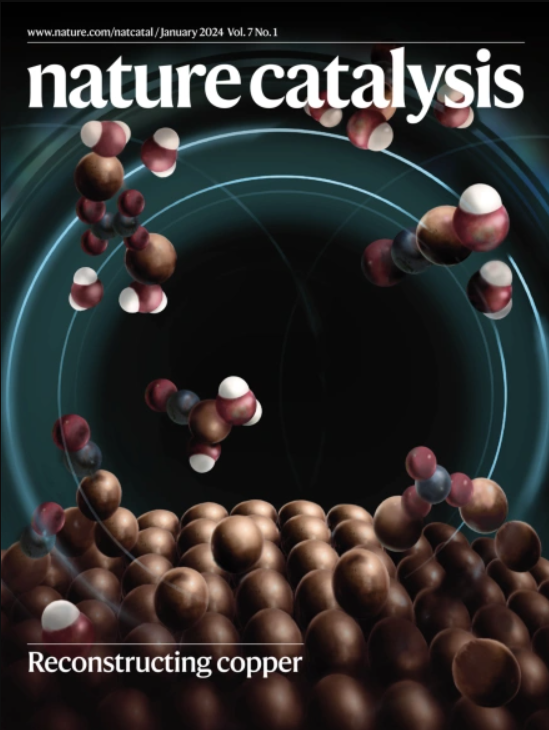General reactive element-based machine learning potentials for heterogeneous catalysis
IF 44.6
1区 化学
Q1 CHEMISTRY, PHYSICAL
引用次数: 0
Abstract
Developing truly universal machine learning potentials for heterogeneous catalysis remains challenging. Here we introduce our element-based machine learning potential (EMLP), trained on a unique random exploration via imaginary chemicals optimization (REICO) sampling strategy. REICO samples diverse local atomic environments to build a representative dataset of atomic interactions, making the EMLP inherently general and reactive, capable of accurately predicting elementary reactions without explicit structural or reaction pathway inputs. We demonstrate the generality and reactivity of our approach by building a Ag-Pd-C-H-O EMLP targeting Pd–Ag catalysts interacting with C/H/O-containing species, achieving quantitative agreement with density functional theory even for complex scenarios such as surface reconstruction, coverage effects and solvent environments, cases for which existing foundation models typically fail. Our method paves the way to replace density functional theory calculations for large and intricate systems in heterogeneous catalysis, and offers a general framework that can readily be extended to other catalytic systems, and to broader fields such as materials science. It is challenging to design machine learning potentials for heterogeneous catalysis that are universal, reactive and have high accuracy. Now, an element-based machine learning potential relying on a random exploration via an imaginary chemicals optimization sampling strategy is put forward, and is successfully demonstrated for a range of applications.

多相催化中基于一般反应元素的机器学习潜力
开发真正通用的多相催化机器学习潜力仍然具有挑战性。在这里,我们介绍了基于元素的机器学习潜力(EMLP),它通过假想化学品优化(REICO)采样策略进行独特的随机探索。REICO对不同的局部原子环境进行采样,以建立原子相互作用的代表性数据集,使EMLP具有固有的一般性和反应性,能够在没有明确的结构或反应途径输入的情况下准确预测基本反应。我们通过构建针对Pd-Ag催化剂与含C/H/ o物质相互作用的Ag-Pd-C-H-O EMLP,证明了我们方法的通用性和反应性,即使在表面重建、覆盖效应和溶剂环境等复杂情况下,我们也与密度泛函理论达成了定量一致,这些情况下现有的基础模型通常都是失败的。我们的方法为多相催化中大型复杂系统的密度泛函理论计算铺平了道路,并提供了一个通用框架,可以很容易地扩展到其他催化系统,以及更广泛的领域,如材料科学。设计具有普遍性、反应性和高准确性的多相催化机器学习潜力是一项挑战。现在,提出了一种基于元素的机器学习潜力,该潜力依赖于通过假想化学品优化采样策略进行随机探索,并成功地在一系列应用中得到了证明。
本文章由计算机程序翻译,如有差异,请以英文原文为准。
求助全文
约1分钟内获得全文
求助全文
来源期刊

Nature Catalysis
Chemical Engineering-Bioengineering
CiteScore
52.10
自引率
1.10%
发文量
140
期刊介绍:
Nature Catalysis serves as a platform for researchers across chemistry and related fields, focusing on homogeneous catalysis, heterogeneous catalysis, and biocatalysts, encompassing both fundamental and applied studies. With a particular emphasis on advancing sustainable industries and processes, the journal provides comprehensive coverage of catalysis research, appealing to scientists, engineers, and researchers in academia and industry.
Maintaining the high standards of the Nature brand, Nature Catalysis boasts a dedicated team of professional editors, rigorous peer-review processes, and swift publication times, ensuring editorial independence and quality. The journal publishes work spanning heterogeneous catalysis, homogeneous catalysis, and biocatalysis, covering areas such as catalytic synthesis, mechanisms, characterization, computational studies, nanoparticle catalysis, electrocatalysis, photocatalysis, environmental catalysis, asymmetric catalysis, and various forms of organocatalysis.
 求助内容:
求助内容: 应助结果提醒方式:
应助结果提醒方式:


